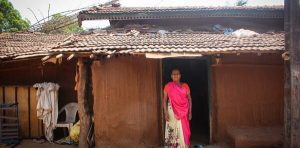Displaced, Jai Bhim Nagar’s Women Are Reclaiming Urban Spaces In Mumbai
Thrown out of their homes eight months ago in a demolition drive, the women of Jai Bhim Nagar are fighting for their right to housing. They are also reclaiming spaces to keep their cultural identity alive
- Priyanka Tupe
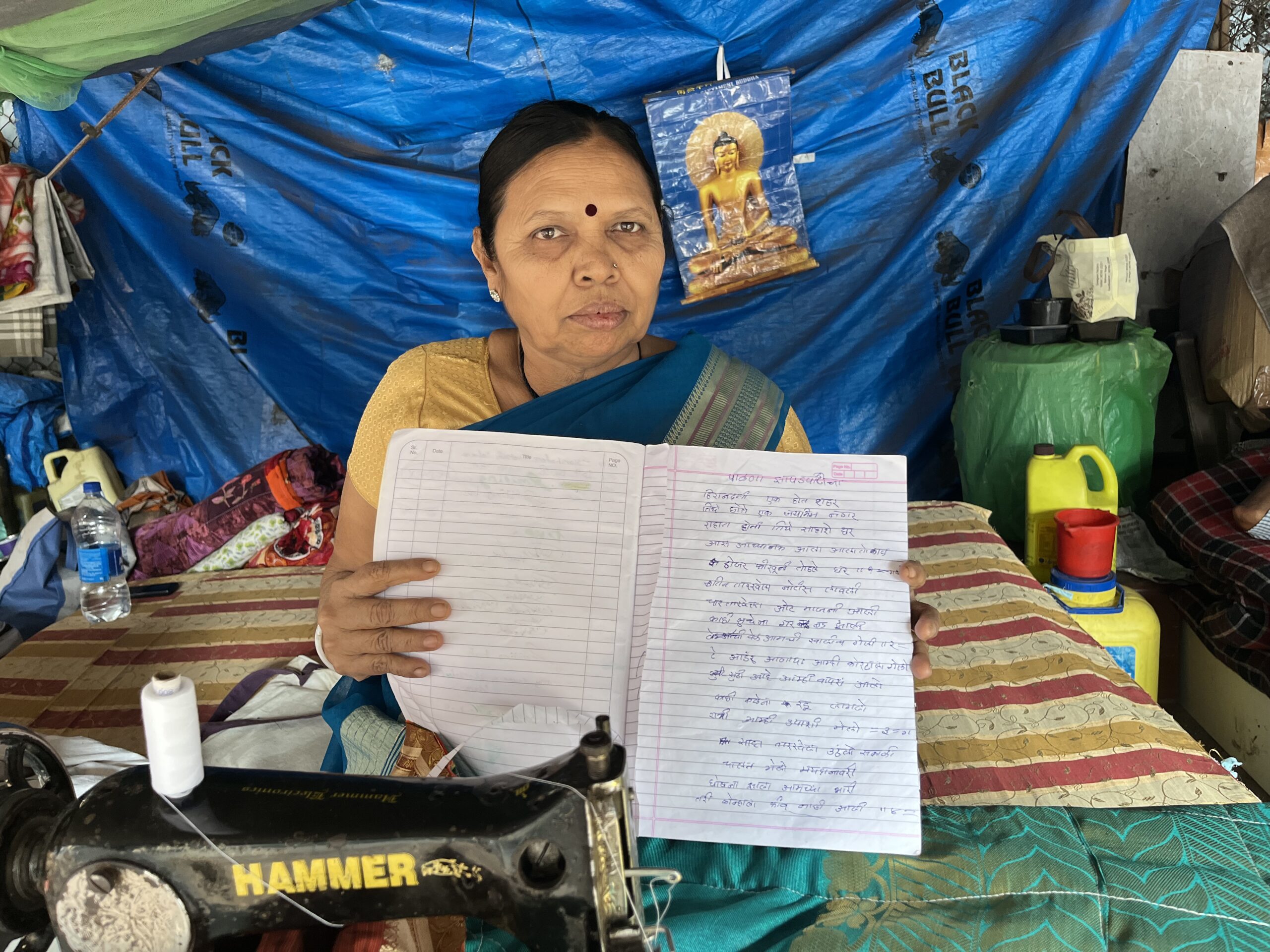
Sushila Khandare, 56, is busy working on a sewing machine on the pavement lining Jai Bhim Nagar in Powai. Though she has nothing more than a sheet of tarpaulin over her head to protect her from the elements, Sushila looks cheerful.
Amidst a small bundle of her belongings lying next to her is an old notebook. In it is a collection of palana (cradle) songs, a folk tradition of Maharashtra, that she has written and titled ‘Palana Zopadapatticha’ or cradle songs from the shanties. They talk of the basti where she lived till last year and the trauma of displacement that followed the demolition of her home and her neighbourhood.
Flipping through the pages of her notebook she goes back to the day she and the other basti residents were evicted from Jai Bhim Nagar. Says her song: “Hiranandani ek hota shahar/ Tithe hote ek Jai Bhim Nagar/ Rahat hoti tithe sahashe ghar/ Asa achank aala to kal (there was once a settlement of 600 homes in a the city of Hiranandani/then came a day in our lives when everything vanished suddenly).”
It was around 10am on June 6, 2024 when over 500 police personnel came in with BMC officials and bulldozers. No one was given the time to collect their belongings, she alleges. But her son managed to salvage the one thing that allows her a livelihood. “He got me my sewing machine, otherwise how could I have survived? We women were beaten and threatened by the police, there were children running around in search of refuge and senior citizens who could not move, all were mercilessly beaten till they left their home,” Sushila recalls.
More than 500 homes/shanties of Jai Bhim Nagar situated in the Hiranandani Gardens complex in Powai, a suburban residential area Mumbai, were demolished in that drive of the Brihan Mumbai Municipal Corporation’s (BMC) to uproot ‘encroachments’. The drive left over 100 people homeless and they live on the footpaths in the area while around 150 families have moved to close localities.
Displaced families from Jai Bhim Nagar living on the pavements in makeshift tents are now fighting for their housing rights using legal options. They are also claiming public spaces through cultural interventions.
More than 100 residents of the basti, 50 of them women, who were affected by demolition approached the Bombay High Court soon after the demolition seeking justice. After eight months something moved – the police recently filed an FIR against several police officers and BMC officials who carried out that demolition drive. However the people of Jai Bhim Nagar said they have no hope of justice.
The basti has been reduced to rubble, and it remains a vacant plot to this date, cordoned off to the public.
“Our problems are increasing by the day but we are yet to hear from the authorities. We had been living at Jai Bhim Nagar since 2004 but lost everything all of a sudden, last year. Despite the FIR, we have received no aid and are even struggling to get adequate water,” a basti resident Shrimati Chauhan said in an interview to Indian Express.
As per the residents of the settlement, an eviction notice was allegedly served – not handed over to the people but stuck on the common toilet’s walls – just three days before the bulldozers arrived. The BMC recognises this land as private property and Hiranandani developers as its owners. “The BMC has also claimed that it received an order from the state human rights commission (SHRC) for evictions because the land was marked as a for labour camp for Hiranandani developers and this had been ‘encroached’ upon by Jai Bhim Nagar residents,” said Huma an activist of ‘Jai Bhim Nagar Bachao’ collective.
However, the SHRC has no evidence of its communications with the BMC, said the women who approached the commission.
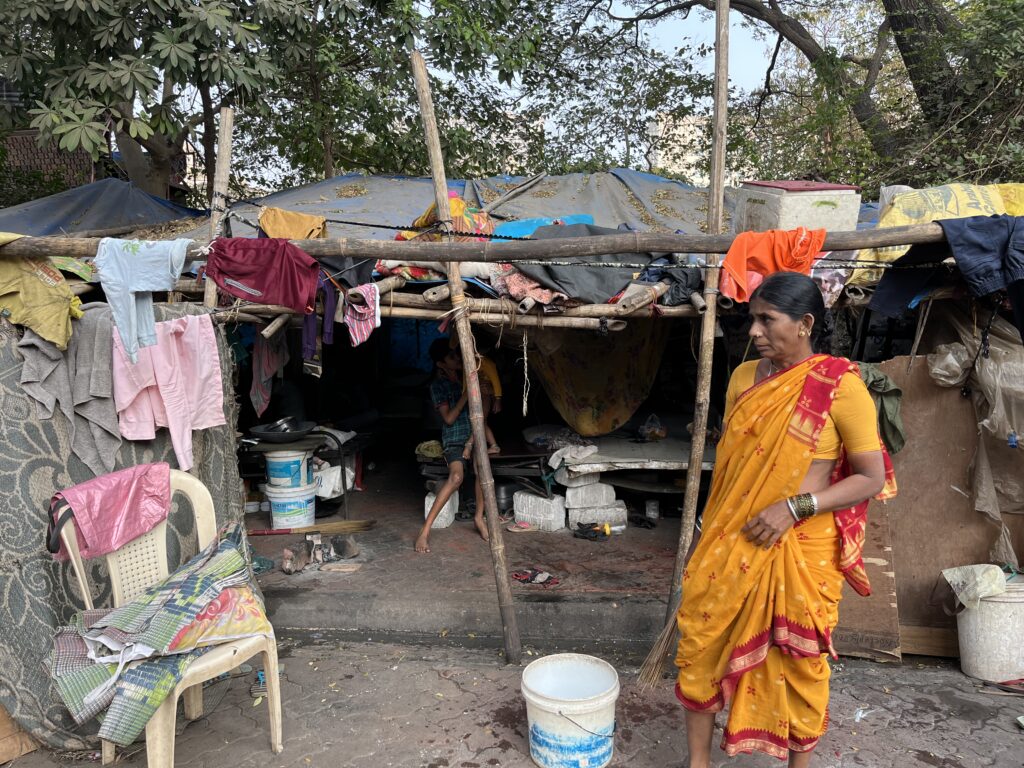
Behanbox has reported extensively on how demolitions disproportionately affect marginalised women (here here and here). We showed how demolitions do not just strip women of their homes, they also shatter their families’ sense of security and belonging while destroying their means of survival. As cities expand, so do the deep divides of inequality, pushing these women further to the margins. The impact of homelessness lingers for generations, leading to poverty and debt traps.
In Jai Bhim Nagar, more than a dozen young children have dropped out of school after the eviction, we found. The displaced women are now adamant that they will be given ‘Ghar ke badale ghar’ (a home in exchange) and the right to a dignified life. They are also fighting invisibilisation with cultural tools – Sushila’s songs are one of these, as is the Sabaki Library, a corner for everyone to come and read.
‘No Home For Us’
Jai Bhim Nagar’s former residents have long roots in the settlement. Sushila Khandare migrated from Yawatmal district of Vidarbha 30 years ago. Meenabai Nimbole, 50, left her home in Nanded district of Marathwada region in search of livelihood. She along with her husband have been working and living in Jai Bhim Nagar for over 30 years now. Reshma Pawar and Shobha Pawar, both in their 30s, grew up in this basti and their parents have been here since 1996.
“We have no land in our hometown in Nanded and repeated droughts made our lives worse there, so we migrated to Mumbai for our survival. My husband has been building the gutters, parks and buildings of Powai since 1996. And what did he receive in return? The police sent him to the Arthur Road Jail for 21 days on the charge of ‘attacking’ them during the demolition,” said Meenabai Nimbole.
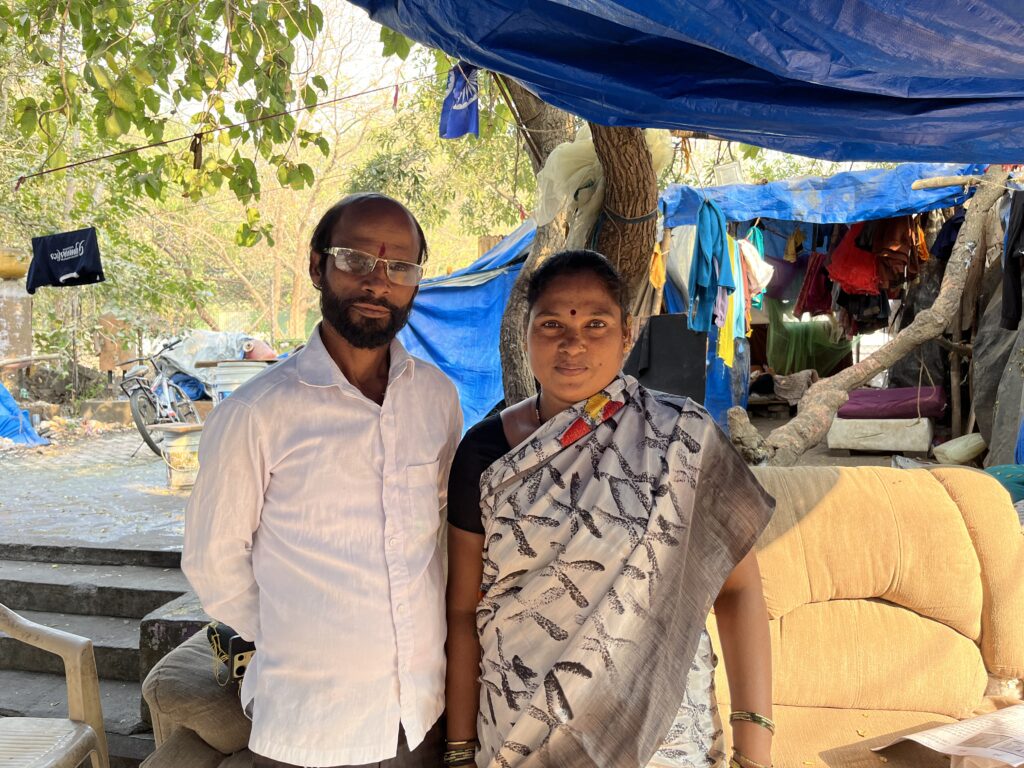
More than 50 people were arrested during the June 2024 demolition drive on charges of ‘stone pelting.’ “We have been building these cities for years, don’t we deserve a piece of land to live in? Those who were homeless were criminalised rather than being provided support,” said Meenabai Nimbole.
Meenabai talked of the trauma of dealing with Mumbai’s torrential monsoons without a pucca home. She cannot afford to rent a 100 sq ft-home in the neighbouring chawl where the monthly rent is as high as Rs 7000. She lives in a makeshift home made with plastic sheets, bamboo and tarpaulin without water and electricity. Sometimes the families receive water from tankers provided by the local administration, but mostly they fetch water from a tap near a public garden.
Shobha Pawar, 30, has rented a one room home in a nearby chawl – with three young daughters living on a footpath is not an option. She earns around Rs 10,000 as a domestic worker employed in the posh homes of Hiranandani’s residential complexes.
The disparities between the shanties on one side of the road and the plush buildings on the other are stark. The security staff of the condominiums do not even allow the basti’s children to stand at the gates of the housing complexes, not even when they are on the footpaths outside.
Everyday Lives
Like Meenabai, most women from Jai Bhim Nagar work as domestic workers in the neighbouring housing societies. This work earns them somewhere between Rs 1000 and Rs 3000 per household. They said the demolition has changed their relationships with their employers.
“My employers didn’t support me when we were homeless during the monsoon. One refused to let me take leave so I could make other arrangements for my family. A couple of others terminated me immediately,” Shobha Pawar recalled.
She said that residents of housing complexes are reluctant to employ those living on the streets citing reasons such as “Raste pe rehnevale logo gande hote hai, unko ham kam nahi de sakte (people who live on the streets are not clean, we cannot employ them)”. Some women, like Shobha, had to rent a room in a chawl to find another job as a domestic worker.
The women of Jai Bhim Nagar were also not allowed to participate in a protest march led by Hiranandani residents demanding justice for the victim of the RG Kar medical college rape and murder. “All these women who live in these posh buildings, directly told us that the protest was not for us,” said Shrimati. Others like Kajal, Nagini, Shobha, Monika too spoke of being denied dignity.
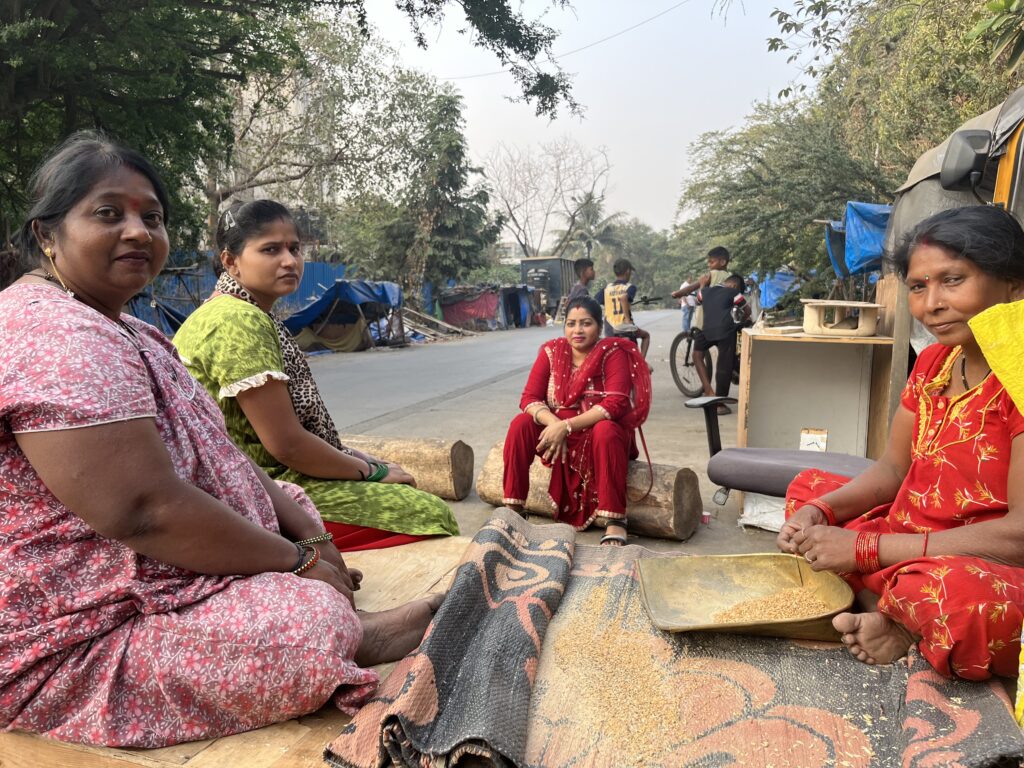
“We are not paid fair salaries: I get Rs 1600 a month to clean the floors of a 3 BHK home. This is so little money, it is likely not even as much as the cost of a pizza. I see food going waste in the homes of the rich while our children starve. And when they do give us some food it is old and stale,” said Nagini, a second-generation domestic worker from Jai Bhim Nagar.
Nagini’s mother, Anita, had been working in Hiranandani homes since before she was born. But Nagini is determined to educate her children and get them out of intergenerational poverty.
A Library For All
With the help of some activists, the women of Jai Bhim Nagar have created a 100-square-feet footpath library, fondly referred to as Sabki Library. There are no large bookshelves, files, tables, or chairs here—just a tent made of cloth and a photograph of Savitribai Phule.
Within this space, young boys and girls, as well as small children, gather to read. They sing, play, and engage in discussions on various topics. Some students prepare for their 10th-grade exams here, while others simply take a moment to rest, forget their poverty, and struggle.
On January 3, Savitribai Phule’s birth anniversary was celebrated here, and on January 26, the Republic Day was observed. Many students volunteer at this space, screening films and facilitating discussions. One such programme was ‘Beghar Chale Begumpura’ (the homeless are walking towards Begumpura). As part of this initiative, local women organised a rally in Jai Bhim Nagar to demand their housing rights.
‘Begumpura’ refers to the Utopia envisioned by the 14th century mystic poet Sant Ravidas—a place without grief (be-gum) where people live in harmony, free from caste, religion, and class-based discrimination. “I felt empowered by the rally, it gave me the confidence to raise a voice for my rights,” said Kajal, a young woman from the basti.
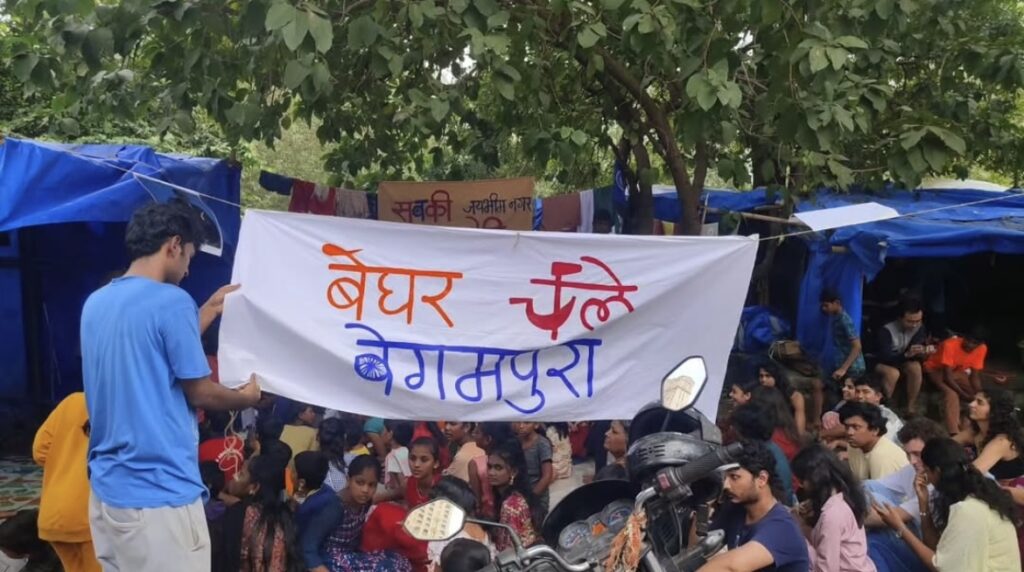
At a recent online discussion, “Struggle for Housing and Other Citizenship Rights”, scholars and human rights activists Anand Teltumbde and Gautam Bhatia spoke of the ongoing fight of the residents of Jaibhim Nagar for rights and justice.
For Meenabai, Mumbai is the city of her dreams and the environs of Jai Bhim Nagar are her home. “I will continue to occupy this street until my last breath,” she said.
We believe everyone deserves equal access to accurate news. Support from our readers enables us to keep our journalism open and free for everyone, all over the world.
